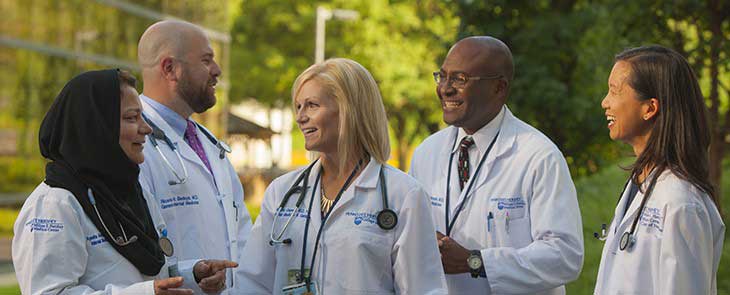Diversifying our workforce means greater excellence and innovation
Our medical centers and practice sites reflect the broader population, which is becoming increasingly more diverse. Research shows that a team of diverse individuals creates more innovative ideas, a higher level of service and a greater competitive advantage. As a result, Penn State Health’s approach to recruitment encourages employees with varied backgrounds to join our organization through activities such as career recruitment fairs and partnerships with diverse organizations, and the health system works to retain those employees.
Penn State Health adopted the Rooney Rule for senior leadership positions in 2016. Through this, we increased the diversity of our executive senior leadership team from 28% to 36% in race/ethnicity, gender and veteran diversity over a four-year period. This protocol became a systemwide policy in 2021, to potentially increase the diversity of hires for leadership positions and physician/faculty roles at the applicant stage, as required by federal employment regulations, and at the interview level. The organization’s overall recruitment efforts have also resulted in an increase in the racial/ethnic diversity representation of physicians from 37% in fiscal year 2021 to 51% in fiscal year 2022, with physician female gender diversity increasing from 42% to 43%.
Our overall workforce diversity is also increasing, based on expanded recruitment efforts.
| Organization | Female Representation | Racial/Ethnic-Representation Minority | Racial/Ethnic-Representation UiM* |
|---|---|---|---|
| Penn State Health | 76% | 18% | 12% |
| Hershey Medical Center | 75% | 17% | 9% |
| St. Joseph Medical Center | 81% | 26% | 23% |
| Holy Spirit Medical Center | 80% | 21% | 15% |
| Hampden Medical Center | 86% | 17% | 12% |
| Lancaster Medical Center | 73% | 22% | 20% |
| Penn State Health Medical Group, Community Practice Division | 82% | 23% | 16% |
| Penn State Health Medical Group, Community Practice Division, Berks Region | 58% | 28% | 15% |
| Penn State Health Life Lion LLC | 39% | 9% | 9% |
| Penn State Health Shared Services | 71% | 15% | 13% |
| *UiM = Underrepresented in Medicine | |||
Our goal is to continue to increase the representation of diverse populations that reflect our patients and community in our physician ranks, nursing professionals and other care provider populations.
We also are creating a work environment that supports the full engagement of diverse individuals through our Business Employee Resource Groups (BERGs). These groups, located at each of our four geographical regions, provide an opportunity for employees to come together and develop recommendations for how Penn State Health can create more inclusive and supportive environments. The groups are formed based on similarity of diversity backgrounds, interests or life experiences, with six areas of focus for employees who:
- Have disabilities or caregiving responsibilities for individuals with disabilities
- Identify as LGBTQ+ or LGBTQ+ allies
- Are serving or have served in the military or are affiliated with someone with military background
- Are affiliated with diverse religious groups, including those traditionally considered underrepresented
- Identify as being from racial/ethnic minority backgrounds, or allies
- Are Generation Y or Z
These groups are open to employees in any of our four regions: Dauphin, Berks, West Shore and Lancaster, with an additional group in Lebanon for military/veteran employees.
Employees also have the opportunity to become inclusion champions – leaders who believe, understand and support diversity, equity and inclusion values in the workplace and community. Champions are committed to advocating, promoting and exemplifying diversity, equity and inclusion.
Culturally responsive care is the road to quality and safety
New Penn State Health employees participate in an orientation program that reviews our organization’s commitment to diversity and inclusion, including an expectation that employees provide culturally responsive care as a foundation for patient quality. This message is also communicated to our new clinicians and nurses in their new employee orientation programs.
In 2016, Penn State Health initiated the Inclusion Academy to provide information on how to care for patients of diverse backgrounds and how to interact more effectively in a diverse work environment. All employees of Penn State Health can take advantage of these sessions to enhance their skills in caring for patients of different backgrounds.
Another educational opportunity for our employees is Inclusion Week, sponsored by the health system Office for Diversity, Equity and Inclusion. This annual weeklong celebration features events that aim to support and foster diversity and inclusion at Penn State Health and the communities we serve. Participants have the opportunity to learn through meaningful and insightful discussions, presentations and workshops on topics that are currently at the forefront of diversity and inclusion and have an impact on our organization, our colleagues and communities around us.
We train the next generation of diverse health care providers
Penn State Health is also committed to increasing the diversity of its residents and fellows. The Network of Under-represented Residents and Fellows (NURF) provides an opportunity for these residents and fellows to network and build a sense of community. Read more about NURF.



